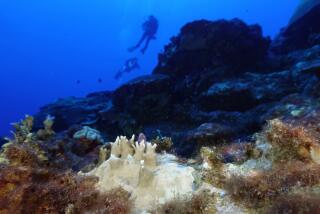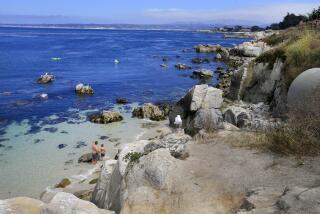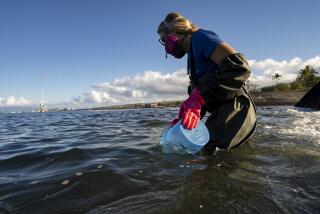Op-Ed: Can the world’s coral be saved?
Two Steps is a perfect snorkeling spot on the Big Island of Hawaii. Black lava rocks step down twice into the clear waters of a small bay where, on a good day, you’re guaranteed to see brightly colored fish and green sea turtles shoaling through myriad forms of coral in shades of brown, green, yellow, pink and purple.
But if you happened to visit last month, you would have found about 30% of the corals bleached wedding-cake white.
It’s a sure sign that the ocean is heating up. Overly warm water causes living coral polyps to expel the photosynthetic algae, called zooxanthellae, that give them their varied colors and about 70% of their nutrients. If the bleaching lasts too long, the corals starve to death.
All of Hawaii’s coral reefs are bleaching this year, a “really serious problem,” says Sheila McKenna, a marine ecologist at Hawaii Volcanoes National Park. And a problem that seems to be accelerating.
With the return of a strong El Niño in the Pacific Ocean and the continued effects of global warming, the National Oceanic and Atmospheric Administration has just declared the third global coral bleaching event in history (the first two took place in 1998 during an earlier El Niño and in 2010). Ninety-five percent of U.S. corals, which are mostly concentrated off the coasts of Hawaii and Florida, are likely to be exposed to conditions that can cause bleaching.
Tropical coral reefs cover less than 1% of the ocean, but they are home and nursery to 25% of all marine species; billions of fish, mollusks and other creatures rely on reefs for their food and shelter. Their beauty generates tourism dollars, and they act as barriers providing storm protection for millions of coastal residents.
Unfortunately, they are especially fragile in the face of pollution, ocean acidification, overfishing and climate change. Most are not expected to survive this century.
There is some hope. Emerging science suggests coral reefs that are fully protected from pollution and overfishing are more resilient to the impact of climate change. That’s one reason a coalition of Hawaii-based groups is calling for an emergency moratorium on the collection of aquarium-trade fish off their reefs.
At the same time, those who care about coral are looking at triage — not every reef will survive.
Wayne Levin, whose underwater photographs can be found in the Museum of Modern Art in New York, sent me a distressed email Sunday from the Big Island:
“I just returned from a one-month trip to the mainland.... When I dove at Keauhou [Bay] I was utterly shocked.... There was an enormous amount of bleached coral. At Honaunau [Two Steps], it was even worse. Almost all the beautiful plate coral along the drop-offs was bleached. Yesterday I dove Ho’okena [Beach] and all the cauliflower and antler coral was bleached. I was completely blown away.... When I left in mid-September all seemed fine. When I returned in mid-October complete devastation.”
Come December and the U.N. climate summit in Paris, our choices for the future will become as starkly black and white as Levin’s photographs of Hawaii’s bleached corals. We can stay on our present path of multiplying disasters or adopt that most basic of survival axioms: If you find yourself in a hole, stop digging.
David Helvarg, executive director of Blue Frontier, is the author most recently of “Saved by the Sea: Hope, Heartbreak and Wonder in the Blue World.” More of Wayne Levin’s photographs can be viewed at waynelevinimages.com
More to Read
A cure for the common opinion
Get thought-provoking perspectives with our weekly newsletter.
You may occasionally receive promotional content from the Los Angeles Times.










